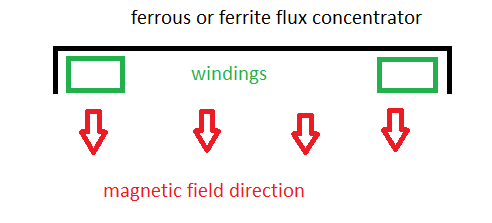-
Posts
2,465 -
Joined
-
Last visited
About jasong
- Currently Viewing Topic: Homemade Coil Skidplate
Profile Information
-
Gender
Not Telling
-
Location:
Wyoming
-
Interests:
supernova flotsam
-
Gear In Use:
7000 w/ X Coils, 6000, EQ800, Deus 1. Heavy equipment, XRF, fire assay furnace, range of sensors. Commercial mineral exploration.
Recent Profile Visitors
jasong's Achievements

Platinum Contributor (6/6)
-
That's a nice result, good work! Just be careful with PVC though, I'm not usually one for nanny warnings but it emits pretty nasty gases at temps that I'm sure a heatgun will get to, at least the surface of the PVC. Hydrogen chloride is hydrochloric acid when a liquid, and carbon monoxide can kill with no ventilation. That's why it's not used for 3D printing anyways. Polycarbonate should be safer. I think TPU would make an interesting skid plate, or even entire coil body requiring no plates, plus way quieter, but it's pricey.
-
The giveaway is that the detector would send itself into a feedback loop when set onto the ground (or sometimes up in air too). That is abnormal. This was my point to Minelab when they kept insisting otherwise and denying it. But it was clear to me after wasting endless time testing in numerous environments eventually that the one constant was the detector causing itself to go unstable. The problem existed no matter where the detector was run - even out among the most remote locations in the Lower-48 with very little EMI around, another indication the detector was the problem and not purely external EMI. This is why I think testing across a wide range of locations/environments is useful. I believe processes like this are ways to determine issues with detectors/design in the field. But I also agree, this is one engineers should have caught too.
- 41 replies
-
- 2
-

-

-
- minelab gpz 7000
- minelab sdc 2300
-
(and 1 more)
Tagged with:
-
Unfortunately AI takes a huge amount of processing power (and energy), or requires cloud (internet) connectivity to run remotely. It's pretty awesome for doing things like coding or writing because it has specific rules, and can run in the cloud on remote supercomputers. Or vision interpretation because there is a huge amount of visual data all around us for it to train on. The problem is niche topics that are also highly interpretational - like figuring out what signals to dig while detecting - would be very difficult to train an AI on, especially since environments change so often place to place. Much better (for now) is algorithmic approaches - largely classed under "signal processing". This can be handled with lower power, onboard hardware and software. Detectors are still underutilizing the capabilities here. However, in terms of EMI reduction there may be some AI approaches that make sense soon, since AI does have capability to find patterns, and thus differentiate things like noise which aren't part of the patterns it finds. However, AI is incredibly slow compared to dedicated algorithmic signal processing hardware.
-
The GPZ is kinda a PI/VLF hybrid on steroids in some ways already, though I guess neither truly. I'm unsure why discrim can't be implemented on ZVT, but if it really can't then it might be interesting to have a button/trigger that kicks it momentarily into VLF mode for target analysis. Or another trigger to kick it into PI mode for salt detecting and quicker differentiation between conductive soil noise and targets. A concentric coil works on all 3. This is the kind of stuff I've been saying for ages that is possible (in theory) with modern circuitry and components increasing in capability and decreasing in costs. As to how feasible it is in the field/actual conditions/usability, no clue.
-

Stacked Spiral Coil Windings
jasong replied to RONS DETECTORS MINELAB's topic in Detector Prospector Forum
One other design I'm curious about is a flat, single layer spiral coil wound with variable winding spacing. No spacing between windings at the center leading to more and more widely spaced windings towards the rim. I might be envisioning it wrong, but it seems like denser winding spacing towards the center and less dense towards the rim may have some kind of flux density shaping effect leaning towards emphasizing more flux at depth (vs a standard coil) directly under the coil, at sacrifice of flux towards the edge of the coil and shallow? But yeah, I totally get the no free lunch. Most of physics can be derived from basic thermodynamic principals, I try to always look at systems from a conservation of energy viewpoint. -

Stacked Spiral Coil Windings
jasong replied to RONS DETECTORS MINELAB's topic in Detector Prospector Forum
Thanks yeah that was what I was envisioning. I figured there would be a definite increase in flux density for near surface (small nugget) detection. Wasn't clear on if there might be deeper effects. The density increase also seems to be kinda "too near" the surface to be useful for general use coils, but for crumbing/dinking coils it might be interesting. That anti-Helmholtz configuration is interesting. Haven't looked at that before, but that seems kinda like achieving similar affects to the Halbach array. That's too bad the flux decreases at depth compared to a single TX though. It definitely seems possible to increase the small/shallow target response. I wonder if there exists some strange or clever design that can trade decreased flux density towards the surface for increased flux density at depth? (well, a design that is actually usable by a human arm anyways 😅) -

Stacked Spiral Coil Windings
jasong replied to RONS DETECTORS MINELAB's topic in Detector Prospector Forum
I'm envisioning the opposite of a ferrite core, more like an exterior casing to concentrate flux such that the amount of magnetic field energy is maximized towards the ground and minimized towards open air. Since half of the field of a coil radiates upwards and thus is not particularly useful for detecting, it seems to make sense to put it where it's more useful - if possible? Here is a cutaway diagram. Would this not have any benefit, at least for near surface flux density concentration? At the field strengths of PI machines I'd guess something like fairly thin 24 gauge steel would be more than enough, saturation is probably ok since the goal would just be some improvement, not capturing all the upwards flux. Is there a way to use that other half of the "wasted" (using that term loosely) magnetic field energy more usefully downwards if this doesn't work? Sort of like the idea behind a Halbach Array, except whatever the EM version would be? Weight alone doesn't have to be a deal breaker. For instance if a hypothetical 12" coil with flux shaping components weighed the same as a 20" standard coil, can it be made to obtain similar depths? If so, then it'd be worth it due to maneuverability with all other things being equal. -
7000 - 15" CC X Coil 6000 - 11" OEM GB2 - 6" elliptical OEM Those 3 coils hardly ever leave any of these detectors now, they suit my prospecting style perfectly. I use the 6000 almost entirely for exploration and thus I prefer the OEM over the smaller Coilteks for ground coverage and depth purposes. It was a hard call between the 15" and 17" CC's, but in the end I realized the times I was glad for a less weight and more mobility were more than the times I was glad for a little more depth, especially as I started working steeper ground.
-

Geoview Found-what Could Be It?
jasong replied to Ethan in Adelaide's topic in Detector Prospector Forum
See if you can get lidar imagery of the area. Prospect pits/spoil piles are easy to see on those, but they have the be high resolution imagery. In the US a lot of the lidar is still the low resolution and the prospects are harder/impossible to see on it, I'm not sure about Australia resolutions. -

Stacked Spiral Coil Windings
jasong replied to RONS DETECTORS MINELAB's topic in Detector Prospector Forum
I wonder if there is any benefit to be had by concentrating flux density via specifically placing ferrous components wound along with a coil (like a steel guitar string for instance). Or ferrite components maybe? Or if that would affect both the ground balance as well as the inductance of the coil such that no (or negative) benefits are gained? -

Stacked Spiral Coil Windings
jasong replied to RONS DETECTORS MINELAB's topic in Detector Prospector Forum
Interesting. The area under each curve should be proportional to the total energy contained in the magnetic field at a given time during the pulse (not equal to, just proportional). So integrating the area below each coil type's curve should give a rough idea of the overall efficiency of each type of coil, by some proportionate factor. IE - It seems to show your wire spacing model which reduces the stray capacitance improves the efficiency of the coil. More of the pulse energy is effectively stored in the magnetic field rather than lost to stray capacitance. It would be interesting to make an algorithmic FE program that brute forces a great number of different designs with the goal of maximizing the area under that curve. Have you experimented with gradient coil windings like they use in MRIs to produce specific linear variations in the field? Not exactly similar, but something like changing winding density along the Z axis? Or other variations... Potentially with the aim of making a really deep coil that doesn't need to be really large at the sacrifice of sensitivity to smaller shallow gold? I guess with these coils there are so few windings that options are kinda limited though. I'm just thinking in terms of shaping those curves to match specific use cases - putting as much of the energy as possible into the places it's needed for different uses, while minimizing energy in the places it's not needed. -
$2000 gold inflation adjusted from 2020 is about $2400 today. Gold so far has basically inflation adjusted itself. In USD anyways. $3000 gold and I bet we see the inklings of another gold rush in places around the world where the geopolitics allow for it. Right now I'm not seeing a big rush to gold exploration again here with the Jr miners/exploration companies yet. But there is some activity. They seem to have interest in diversifying to copper/gold deposits though. But I'm hearing some whispers of interest whereas it was kinda dead for a few years. Uranium is the new lithium. Lots of renewed activity.
-

Minelab Fy23 Investor Presentation For 2024 - No GPZ 8000?
jasong replied to phrunt's topic in Minelab Metal Detectors
Keep in mind though - I said the same statement after using the X Coils (and I got flack for it too). I said to me the X Coils obsolete the need for the NF coil. And I still stand by that statement today. But the NF is good coil - great to those unwilling to cut a cable. But to me, that coil was obsolete before it was even released. Similarly, my 4500 hasn't left my closet since I got X Coils and especially since I got my 6000. The 4500 and 5000 are to me very obsolete platforms - I have zero interest ever running them again. And I believe as a platform, the 7000 itself in terms of electronics design and ergonomics is already close to obsolete if it had any serious competitor. It's an old, stodgy, dinosaur platform to me that feels like how the 3500 felt to me when I first started detecting for gold. If not for the X Coils, I doubt I'd use it much anymore quite honestly, but I also don't do a lot of ultra accurate patch cleaning anymore these days either, clearly there is no equal to it yet there. -

Minelab Fy23 Investor Presentation For 2024 - No GPZ 8000?
jasong replied to phrunt's topic in Minelab Metal Detectors
The reason I am stating my opinion is based on what I am reading in the old and newer modified ZVT patents Bruce Candy outlines that technically speaking, ZVT should be superior to any type of PI due to the relative lack of X contamination during sampling without the pulse decay, as well as the lack of a decay time interfering with target sampling. That isn't what we are seeing today with current models though. At least not exactly. Given that the SDC (IMO anyways) has better or at least equal X ground performance generally than the 7000, and that the 6000 can almost keep up with the GPZ in terms of small bit sensitivity - it stands to reason that the 7000 implementation of ZVT was not optimal early on and has room for measurable improvement. From that, it would stand to reason that almost 10 years of development time should have resulted in a more optimal ZVT implementation by now. Especially in terms of dealing with X component in soils, as well as further refining target sampling improvements. If I've made an error in reasoning there, I'd be curious what it is. Because lacking insider information, that seems like the logical conclusion to make based on the data the public have at hand. I understand the whole withhold technology at a drip pace thing Minelab does, for sure. That's another issue, it's hard to predict what the business department does though, and I suspect it changes with the wind sometimes, so I refrain from speculating there. But if they release an 8000 with better X handling than the SDC, improved target response for both short and long time constants, and more ergonomic to match the 6000 then I stand by my statement - to me that would obsolete the SDC, 6000, and 7000 entirely - as in - I doubt I'd use any of those 3 again if I had such a machine. Improve the EMI filtering and my opinion would likely be strengthened. -

Minelab Fy23 Investor Presentation For 2024 - No GPZ 8000?
jasong replied to phrunt's topic in Minelab Metal Detectors
Well alright then. Pardon my lack of industry connections in which to base my own opinions, I am of course limited to the public information the rest of us are limited to. I detailed the reasoning behind my opinion. But if the conversation is just "I know secret things" then I guess there isn't much to talk about is there? While I may be disappointed if the 8000 doesn't meet my expectations, it's a minor thing. I have more fun looking at technical data available and thinking about what might be. But that's turned into no fun here with the sarcasm, so I'll move on.


.thumb.jpg.008984156b596a0063f90b0d7fbc295b.jpg)



.thumb.jpg.95344db3aeef0a4c6c73420daa366191.jpg)



